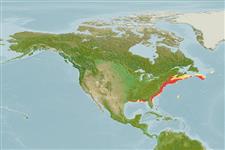Environment: milieu / climate zone / depth range / distribution range
Ökologie
seewasser; brackwasser demersal; tiefenbereich 10 - 183 m (Ref. 5951). Temperate; 54°N - 29°N
Western Atlantic: Newfoundland in Canada to northeastern Florida in USA.
Size / Gewicht / Alter
Maturity: Lm ? range ? - ? cm
Max length : 36.0 cm TL Männchen/unbestimmt; (Ref. 7251); common length : 20.0 cm TL Männchen/unbestimmt; (Ref. 3821)
Kurzbeschreibung
Morphologie | Morphometrie
Rückenflossenstacheln (insgesamt): 0; Rückenflossenweichstrahlen (insgesamt): 8; Afterflossenstacheln 0; Afterflossenweichstrahlen: 7. Upper side grey or brown with poorly defined black spots and saddles. Belly yellow to white. Tiny jet-black pepper spots (about 1 mm in diameter) scattered over most of pigmented surface, particularly evident on cheeks. Lower sides with a row of black, elongate, bar-like markings. No lappets on head or body (Ref 53033).
Inhabits bays, estuaries and protected coastal waters. Sold as `sea squab' in northern part of range. Feeds primarily on shellfish, occasionally on finfish. Reportedly non-toxic.
Life cycle and mating behavior
Geschlechtsreife | Fortpflanzung | Ablaichen | Eier | Fecundity | Larven
Robins, C.R. and G.C. Ray, 1986. A field guide to Atlantic coast fishes of North America. Houghton Mifflin Company, Boston, U.S.A. 354 p. (Ref. 7251)
IUCN Rote Liste Status (Ref. 130435)
Bedrohung für Menschen
Harmless
Nutzung durch Menschen
Fischereien: weniger kommerziell; Aquarium: Kommerziell
Tools
Zusatzinformationen
Download XML
Internet Quellen
Estimates based on models
Preferred temperature (Ref.
123201): 4.9 - 24.4, mean 9.3 °C (based on 71 cells).
Phylogenetic diversity index (Ref.
82804): PD
50 = 0.5000 [Uniqueness, from 0.5 = low to 2.0 = high].
Bayesian length-weight: a=0.02291 (0.01026 - 0.05115), b=2.89 (2.72 - 3.06), in cm total length, based on LWR estimates for this Genus-body shape (Ref.
93245).
Trophic level (Ref.
69278): 4.0 ±0.66 se; based on food items.
Widerstandsfähigkeit (Ref.
120179): hoch, Verdopplung der Population dauert weniger als 15 Monate. (K=0.6).
Fishing Vulnerability (Ref.
59153): Low vulnerability (24 of 100).
Climate Vulnerability (Ref.
125649): Low vulnerability (22 of 100).
Nutrients (Ref.
124155): Calcium = 38.7 [16.1, 97.2] mg/100g; Iron = 0.415 [0.167, 0.986] mg/100g; Protein = 18.3 [16.1, 20.6] %; Omega3 = 0.641 [0.299, 1.355] g/100g; Selenium = 15.5 [6.7, 35.4] μg/100g; VitaminA = 7.65 [2.05, 30.83] μg/100g; Zinc = 0.49 [0.34, 0.77] mg/100g (wet weight);
